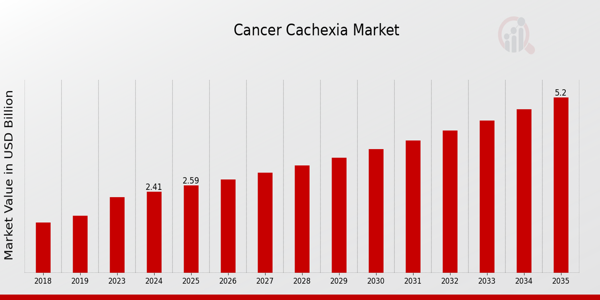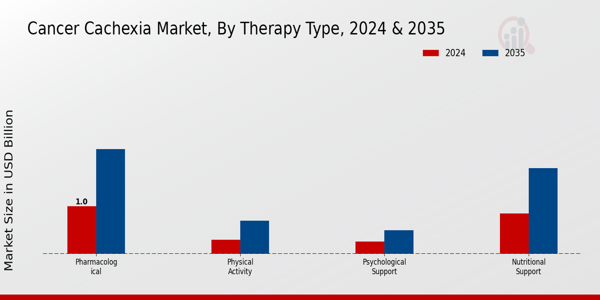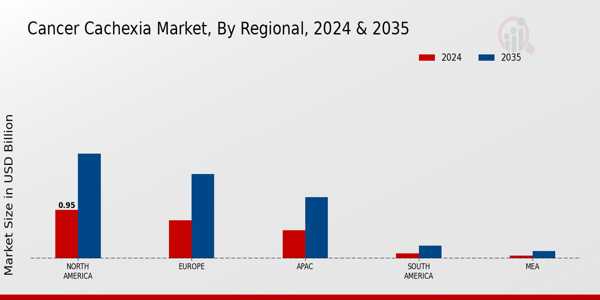Cancer Cachexia Market Overview
As per MRFR analysis, the Cancer Cachexia Market Size was estimated at 2.25 (USD Billion) in 2023.The Cancer Cachexia Market is expected to grow from 2.41(USD Billion) in 2024 to 5.2 (USD Billion) by 2035.The Cancer Cachexia Market CAGR (growth rate) is expected to be around 7.24% during the forecast period (2025 - 2035).
Key Cancer Cachexia Market Trends Highlighted
The growing incidence of cancer and growing recognition of cachexia as a serious side effect in cancer patients are driving notable developments in the global cancer cachexia market. The increasing emphasis on enhancing patient quality of life and survival rates through targeted nutritional support and cachexia-addressing therapeutic therapies is a significant market driver.
Furthermore, prospects for more effective treatments are being created by developments in biotechnology and targeted therapeutics, which will ultimately increase market need for creative solutions. Expanding clinical trials and research to better understand the underlying causes of cachexia presents opportunities for the creation of more specialized treatment alternatives.
A multidisciplinary approach to care that incorporates dietary assistance in addition to traditional treatments is crucial, as seen by the growing popularity of integrating nutritional therapy into cancer management.
The healthcare industry has recently shifted to a more patient-centered approach, which promotes the use of holistic approaches that prioritize overall patient wellness, including the treatment of symptoms like cachexia, in addition to tumor elimination.
Policies that support research and increase access to treatment are becoming increasingly common as governments and healthcare institutions around the world begin to acknowledge the financial burden that cancer-related cachexia poses. This advancement in our knowledge of cancer cachexia is probably going to drive market expansion and improve patient care globally.

Source: Primary Research, Secondary Research, MRFR Database and Analyst Review
Cancer Cachexia Market Drivers
Increasing Prevalence of Cancer Patients
The rise in the number of cancer patients globally is a significant driver for the Global Cancer Cachexia Market. Reports indicate that globally, the incidence of cancer has increased by approximately 19.3 million new diagnoses in 2020 alone.
This alarming figure highlights the growing need for effective cancer management strategies, including the treatment of cancer cachexia. The World Health Organization (WHO) projects that cancer prevalence will continue to rise, emphasizing the necessity for innovative therapies.
As cancer-associated cachexia significantly impacts patient outcomes, pharmaceutical companies are increasingly investing in Research and Development to create specialized treatments for this condition.
Major pharmaceutical firms such as Pfizer and Roche have also been actively pursuing new treatments through strategic partnerships and alliances aimed at addressing nutritional deficiencies in cancer patients, thus contributing to the market's growth.
Advancements in Therapeutic Solutions
Technological advancements in therapeutic solutions for cancer cachexia are another crucial driver for the Global Cancer Cachexia Market. The integration of biotechnology and nutrition science has led to the development of novel treatment options that address cachexia directly.
Recent studies have shown that new drug formulations, including anti-inflammatory agents and appetite stimulants, can effectively mitigate the effects of cachexia.
For instance, the National Cancer Institute has reported successful clinical trials of new cachexia drugs, leading to increased interest from major pharmaceutical companies in this niche segment. This advancement suggests that there is a promising growth opportunity as healthcare providers and oncology specialists seek efficient therapeutic interventions to improve patient quality of life.
Rising Awareness and Advocacy for Cachexia Management
There is a growing awareness and advocacy regarding the management of cancer cachexia, which positively influences the growth of the Global Cancer Cachexia Market.
Various non-profit organizations, including the American Cancer Society, are not only educating patients and healthcare professionals about the implications of cachexia but are also pushing for policy changes to allocate more research funds for this condition.
Such initiatives have seen an increase in support for clinical guidelines on cachexia management among oncologists. As educational campaigns continue to raise awareness, it is likely that more patients will seek treatment options, driving growth in this sector as healthcare providers become better informed about acknowledging and addressing cachexia.
Government Initiatives and Funding for Cancer Research
Government initiatives and funding aimed at cancer research play a substantial role in propelling the growth of the Global Cancer Cachexia Market. Regions such as the United States and members of the European Union have significantly increased their funding commitment towards cancer research and development, including cachexia-related studies in recent years.
For instance, the National Institutes of Health (NIH) has allocated a considerable budget specifically for researching cancer cachexia, spotlighting its importance within the oncology community.
Such funding enables universities and research institutions to pursue comprehensive studies, leading to the development of effective treatment protocols. As the support from global health organizations continues to grow, the market potential for innovative therapies specifically targeting cancer cachexia is expected to expand significantly.
Cancer Cachexia Market Segment Insights
Cancer Cachexia Market Therapy Type Insights
The Global Cancer Cachexia Market, focusing on the Therapy Type segment, revealed a robust and diverse landscape aimed at addressing the multifaceted challenges faced by cancer patients. This segment highlighted the urgent need for effective interventions for cachexia, a complex syndrome associated with cancer characterized by severe weight loss and muscle wasting.
Among the various therapy types, the Pharmacological approach held a majority share with a valuation of 1.0 USD Billion in 2024 and is expected to expand to 2.2 USD Billion by 2035. This growth was primarily driven by advancements in drug development and research which were continuously working to improve the quality of life for patients suffering from cancer cachexia.
Nutritional Support followed closely, valued at 0.85 USD Billion in 2024, indicating its crucial role as a foundational therapy for managing cachexia symptoms, with market expectations anticipating a rise to 1.8 USD Billion by 2035.
The increasing recognition of nutritional needs in cancer care underscored the importance of dietary management and supplementation in fostering a supportive therapeutic environment.
In addition, Physical Activity, although a smaller segment valued at 0.3 USD Billion in 2024, is projected to see an upsurge to 0.7 USD Billion in 2035. The growing body of evidence supporting the benefits of exercise in rehabilitation and recovery lends significant validity to this therapy type, making it an integral component of holistic cancer treatment.
Lastly, Psychological Support, valued at 0.26 USD Billion in 2024 and potentially reaching 0.5 USD Billion by 2035, played a vital role in addressing the emotional and psychological challenges faced by patients.
With an increasing focus on mental health in oncology, this segment is gaining traction as an essential aspect of comprehensive care, ensuring patients receive well-rounded support during their treatment journey.
The overall market data demonstrated a strong growth trend across all therapy types in the Global Cancer Cachexia Market, driven by rising cancer prevalence, increased awareness about cachexia, and ongoing research focused on improving therapeutic strategies.
Each of these therapy types served a significant purpose in addressing the needs of cancer patients, offering a synergistic approach that is crucial for enhancing patient outcomes and quality of life, and reflected a commendable evolution in cancer care strategies globally.

Source: Primary Research, Secondary Research, MRFR Database and Analyst Review
Cancer Cachexia Market Distribution Channel Insights
The Global Cancer Cachexia Market is expected to showcase significant growth within various distribution channels. As the market evolves, it is crucial to understand the dynamics of distribution channels such as hospitals, clinics, online pharmacies, and retail pharmacies.
Hospitals are anticipated to play a pivotal role, typically serving a large volume of cancer patients needing immediate nutritional support. Clinics also contribute substantially, as they provide personalized treatment options that cater specifically to cancer cachexia.
The rise of online pharmacies has revolutionized accessibility, allowing patients to order necessary products conveniently from their homes, which is increasingly important in today's digital age. Retail pharmacies continue to dominate due to their physical presence and immediate access to essential medications and supplements.
Overall, the growing healthcare infrastructure and increasing awareness surrounding cancer cachexia treatment options are expected to drive the market growth across all distribution channels in the Global Cancer Cachexia Market.
With diverse engagement in these channels, healthcare providers and patients alike are increasingly prioritizing the availability and distribution of critical nutritional support infrastructure, thus influencing the Global Cancer Cachexia Market revenue positively.
Cancer Cachexia Market End User Insights
The Global Cancer Cachexia Market is seeing significant growth, particularly within the End User segment, which comprises Hospitals, Homecare, Healthcare Institutions, and Research Organizations. Hospitals remain a pivotal sector due to their role in the direct treatment of cancer patients, while Homecare has emerged significantly, providing personalized care that alleviates the burden on healthcare facilities.
Healthcare Institutions contribute by prioritizing research and advancements in treatment methods, thus playing a vital role in evolving care strategies. Additionally, Research Organizations are critical in developing innovative therapies and creating more effective interventions, pushing boundaries toward improving patient outcomes.
The combination of these sectors illustrates a unified approach to tackling cancer cachexia, with key drivers including an aging global population and increased cancer cases, while challenges lie in funding and resource allocation for extensive research.
Together, these factors contribute to a dynamic landscape within the Global Cancer Cachexia Market, reflecting evolving patient care needs and innovative treatment methodologies.
Cancer Cachexia Market Regional Insights
The Global Cancer Cachexia Market presented a diverse regional landscape, with North America dominating the segment, valued at 0.95 USD Billion in 2024 and projected to reach 2.05 USD Billion in 2035. This growth was supported by advanced healthcare infrastructure and significant Research and Development initiatives in the region.
Europe followed, with a valuation of 0.75 USD Billion in 2024, anticipated to grow to 1.65 USD Billion by 2035, driven by increased awareness and diagnosis rates of cancer cachexia. The Asia-Pacific (APAC) region was also a noteworthy segment, valued at 0.55 USD Billion in 2024 and expected to grow to 1.2 USD Billion, highlighting increasing healthcare investments and a rising aging population.
Meanwhile, South America and the Middle East and Africa (MEA) held smaller portions of the market, with valuations of 0.1 USD Billion and 0.06 USD Billion respectively in 2024, indicating their developing healthcare systems and potential growth opportunities.
The overall Global Cancer Cachexia Market revenue showcased a robust trend, with diverse regional activities contributing to a comprehensive understanding of market segmentation and driving overall market growth.

Source: Primary Research, Secondary Research, MRFR Database and Analyst Review
Cancer Cachexia Market Key Players and Competitive Insights
The Global Cancer Cachexia Market is characterized by a dynamic and competitive landscape, driven by the increasing prevalence of cancer and the urgent need for effective treatment options to address cachexia, a multifaceted syndrome associated with significant weight loss and muscle wasting.
Several key players in this market are engaged in developing therapies to improve the quality of life for patients battling cancer and its related complications. The competitive insights of this market reveal a mix of pharmaceutical companies, research institutions, and biotech firms that are racing to innovate and secure their presence in this critical healthcare segment.
The ongoing research and development efforts are often fueled by strategic collaborations and partnerships, allowing companies to leverage their strengths and resources in pursuit of novel therapies that can meet the unmet medical needs in cancer cachexia treatment.
Pfizer is a prominent player in the Global Cancer Cachexia Market, recognized for its research-driven approach and extensive portfolio of pharmaceutical products. The company's investments in R&D have resulted in a strong pipeline of potential therapeutic agents targeting cachexia, thereby positioning Pfizer favorably in this competitive environment.
The company's well-established reputation and presence in global markets allow it to leverage distribution channels efficiently and reach a vast patient population. Additionally, Pfizer's strong financial backing enables sustained investment in innovative therapies, clinical trials, and collaborations with academic institutions, further enhancing its competitive edge in addressing cachexia.
Kyoto University, a renowned research institution, has made significant strides in the Global Cancer Cachexia Market through its pioneering research and development initiatives. This institution is known for its focus on translating scientific discoveries into innovative therapeutic solutions.
The key products and services developed by Kyoto University aim to tackle the biochemical pathways involved in cancer cachexia, enhancing its therapeutic offerings in this domain. The university's prominent stature in the global research community fosters collaboration with leading biotech firms, enabling successful mergers and acquisitions that bolster its presence and influence within the market.
Through its scientific expertise and commitment to advancing treatments for cancer cachexia, Kyoto University continues to play a vital role in addressing this pressing healthcare challenge on a global scale.
Key Companies in the Cancer Cachexia Market Include
- Pfizer
- Kyoto University
- Yale University
- AbbVie
- Roche
- Eli Lilly
- Bristol Myers Squibb
- GSK
- Novartis
- Mylan
- Teva Pharmaceuticals
- Merck
- AstraZeneca
- Amgen
- Sanofi
Cancer Cachexia Market Developments
Significant advancements in the Global Cancer Cachexia Market include the intensified focus on innovative treatments, with companies like Pfizer and AbbVie investing in clinical trials to improve patient outcomes. The regulatory landscape is evolving, with increased collaborations between academic institutions such as Kyoto University and Yale University to enhance Research and Development efforts.
In a notable development, Roche announced the initiation of pivotal trials on their leading cachexia candidate in April 2023, which could substantially impact therapeutic approaches. Meanwhile, companies like Novartis and Eli Lilly have reported expanding their pipelines for cachexia, with stronger emphasis on leveraging biological markers for more targeted therapies.
Mylan's acquisition of a small biotech firm in February 2023 has strengthened its portfolio in oncology, while Merck has made strides in formulation enhancements, aiming for improved patient adherence. Furthermore, the market valuation of key players has witnessed significant growth; Bristol Myers Squibb has seen a notable uptick in stock performance due to positive trial results that leverage cachexia management.
The increasing prevalence of cancer globally, coupled with a rising understanding of cachexia mechanisms, further drives interest and investment in this vital sector.
Cancer Cachexia Market Segmentation Insights
Cancer Cachexia Market Therapy Type Outlook
- Pharmacological
- Nutritional Support
- Physical Activity
- Psychological Support
Cancer Cachexia Market Distribution Channel Outlook
- Hospitals
- Clinics
- Online Pharmacies
- Retail Pharmacies
Cancer Cachexia Market End User Outlook
- Hospitals
- Homecare
- Healthcare Institutions
- Research Organizations
Cancer Cachexia Market Regional Outlook
- North America
- Europe
- South America
- Asia Pacific
- Middle East and Africa
| Report Attribute/Metric Source: |
Details |
| MARKET SIZE 2023 |
2.25(USD Billion) |
| MARKET SIZE 2024 |
2.41(USD Billion) |
| MARKET SIZE 2035 |
5.2(USD Billion) |
| COMPOUND ANNUAL GROWTH RATE (CAGR) |
7.24% (2025 - 2035) |
| REPORT COVERAGE |
Revenue Forecast, Competitive Landscape, Growth Factors, and Trends |
| BASE YEAR |
2024 |
| MARKET FORECAST PERIOD |
2025 - 2035 |
| HISTORICAL DATA |
2019 - 2024 |
| MARKET FORECAST UNITS |
USD Billion |
| KEY COMPANIES PROFILED |
Pfizer, Kyoto University, Yale University, AbbVie, Roche, Eli Lilly, Bristol Myers Squibb, GSK, Novartis, Mylan, Teva Pharmaceuticals, Merck, AstraZeneca, Amgen, Sanofi |
| SEGMENTS COVERED |
Therapy Type, Distribution Channel, End User, Regional |
| KEY MARKET OPPORTUNITIES |
Growing elderly population, Increasing awareness campaigns, Advancements in nutritional supplements, Enhanced drug development, Integration of telehealth solutions |
| KEY MARKET DYNAMICS |
Rising cancer prevalence, Increasing geriatric population, Advancements in therapeutics, Growing focus on symptom management, Awareness of nutritional interventions |
| COUNTRIES COVERED |
North America, Europe, APAC, South America, MEA |
Frequently Asked Questions (FAQ) :
The Global Cancer Cachexia Market is expected to be valued at 2.41 USD Billion in 2024.
By 2035, the Global Cancer Cachexia Market is projected to reach 5.2 USD Billion.
The expected CAGR for the Global Cancer Cachexia Market from 2025 to 2035 is 7.24 percent.
North America is projected to hold the largest market share in the Global Cancer Cachexia Market by reaching 2.05 USD Billion in 2035.
The pharmacological therapy type in the Global Cancer Cachexia Market is valued at 1.0 USD Billion in 2024.
The nutritional support segment is forecasted to reach 1.8 USD Billion in the Global Cancer Cachexia Market by 2035.
Major players in the Global Cancer Cachexia Market include Pfizer, AbbVie, Roche, and Merck.
The Asia-Pacific region is expected to have a market size of 1.2 USD Billion in the Global Cancer Cachexia Market by 2035.
The psychological support segment is valued at 0.26 USD Billion in 2024 for the Global Cancer Cachexia Market.
Challenges anticipated in the Global Cancer Cachexia Market growth may include limited awareness and accessibility of therapies.

















